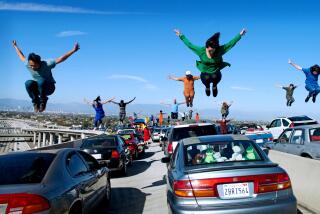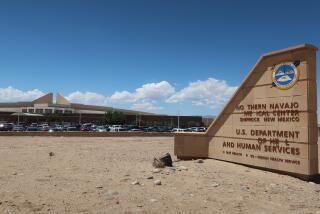Olympic Exhibit to Offer Trip Through History With Navajo
- Share via
ALBUQUERQUE, N.M. — Architect David Sloan views the opportunity to design a Navajo Nation exhibit for the 2002 Olympics as a chance to come full circle.
“Personally, the Navajo Nation has given me a lot of opportunity,” Sloan said, such as paying for part of his education. “I’m giving back what I’ve learned.”
Sloan, 51, was born and raised on the reservation in Rehoboth, N.M.
Navajo officials hope that the exhibit will provide an economic boost and open up a world of opportunity.
“Discover Navajo: People of the Fourth World” is the name of the interactive exhibit that will be part of the 2002 Cultural Olympiad, the arts festival surrounding the winter games. The exhibit will be in downtown Salt Lake City.
“The exhibit is designed to tell the Navajo creation stories and take you through their histories into the modern-day world,” said Marilyn Ellingson, project coordinator in Salt Lake City.
It will replicate a 19th-century homestead with a hogan, sheep corrals, sweat lodge and loom, she said. The exhibit will also feature history on the Navajo Code Talkers, a special Navajo signal unit organized by the U. S. Marines to communicate unbreakable codes in World War II, and the work of many Navajo artists and storytellers.
“Even though we have the temporary structures that are predesigned, we’ll try to bring in these other elements that will bring in the traditional feel,” Sloan said.
“The biggest item is trying to present the landscape of the Navajo Nation, trying to figure out the vast landscape,” Sloan said.
In addition to the educational value, the Navajos see this project as a great economic initiative that could improve tourism and draw businesses to the reservation, said Fred White, tourism director for the tribe.
The tribe is one of the few in the Southwest that has not based its economy on tribal casino revenue. Instead, the Navajos have chosen to stick to more traditional ways of life emphasizing art, jewelry-making and agriculture.
“This project is set up to promote Navajo in terms of what we have--the beauty of the land and the cultural experience,” White said.
“Our people really live their culture. The majority of our people are respectful to concepts of family, concepts of spirituality and look at controversial things as things they shouldn’t be supporting,” he said, referring to gambling.
The Navajo Council has allocated $1.75 million to the exhibit.
“We’re also looking . . . to connect through our networking opportunities, to meet with corporate people to learn about other opportunities,” White said. “Something might come up where they’d bring a business to Navajo land.”
A site has been selected for the exhibit, and designs are close to completion. The project has a $4-million budget; about half of that has been raised, White said. The exhibit will occupy about 14,500 square feet, Sloan said.
The Navajos won’t be the only American Indian tribe represented in Salt Lake City.
The Festival of Nations, which will be adjacent to the Navajo exhibit, will bring together tribes from several states to celebrate their rich spiritual and artistic cultures. The festival will showcase traditional and contemporary music, performing and visual arts, dance and native foods such as blue corn.
A replica of the Hubbell Trading Post will serve as a general store for souvenirs and American Indian products. The real trading post is a national historic site near Ganado, Ariz., that in 1876 became the lifeline of supplies for Navajos looking to reestablish themselves following the Long Walk of 1864.
White said he has verbal commitments from several Western Indian tribes but plenty of room remains. “We have an open door if tribes are interested,” he said.
Although the Olympics is the reason for creation of the exhibit, its life won’t end there. The goal is to establish some contacts during the Olympics and take the show on the road, both in the United States and abroad, Ellingson said.
“The opportunities for the long-term are just extraordinary,” she said.
Other tribes participating in the Festival of Nations will be invited to accompany the exhibit on tour.
“I think it’s an exciting project, and we look forward to sharing our culture with other people across the world,” White said.
More to Read
Sign up for Essential California
The most important California stories and recommendations in your inbox every morning.
You may occasionally receive promotional content from the Los Angeles Times.









